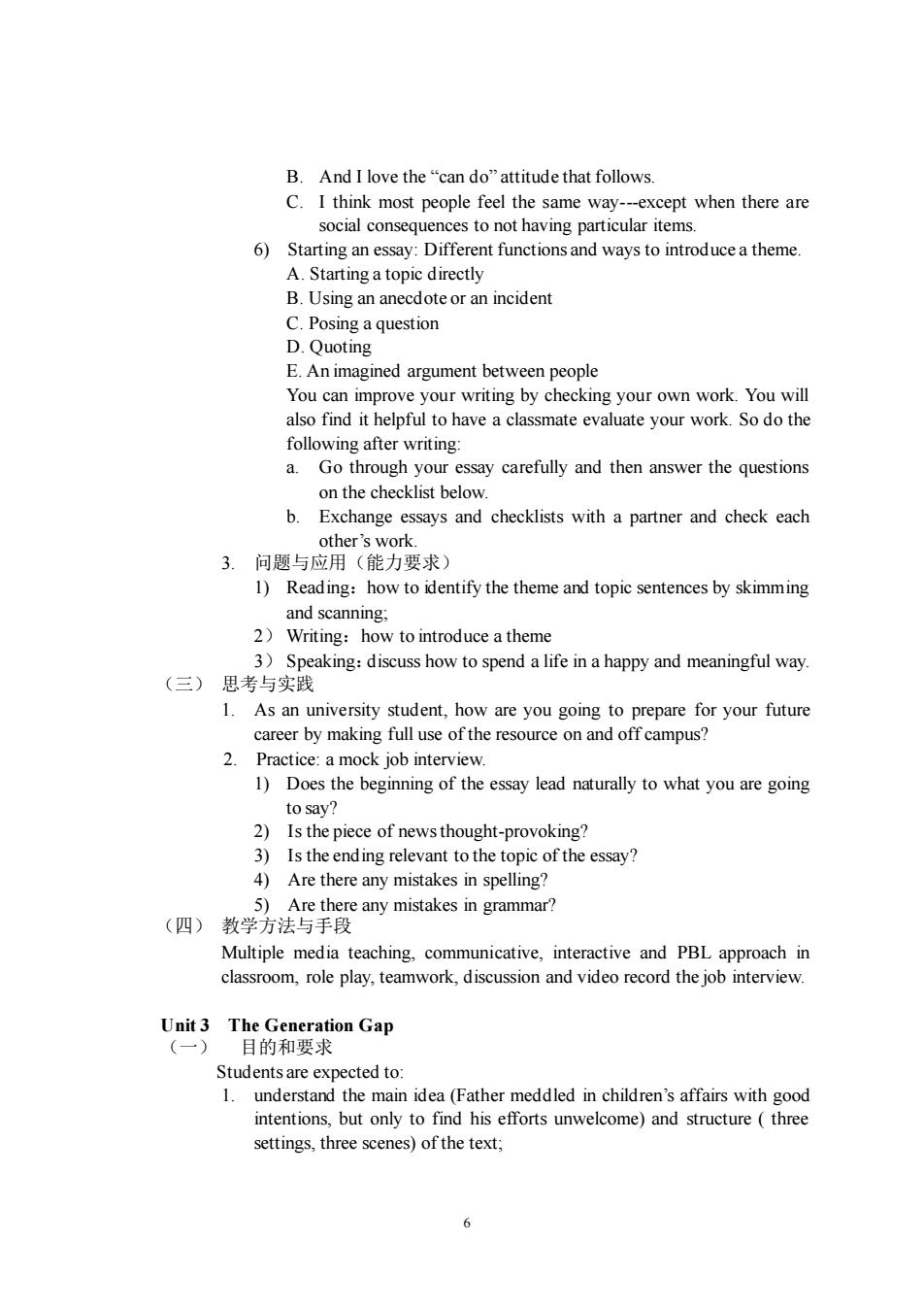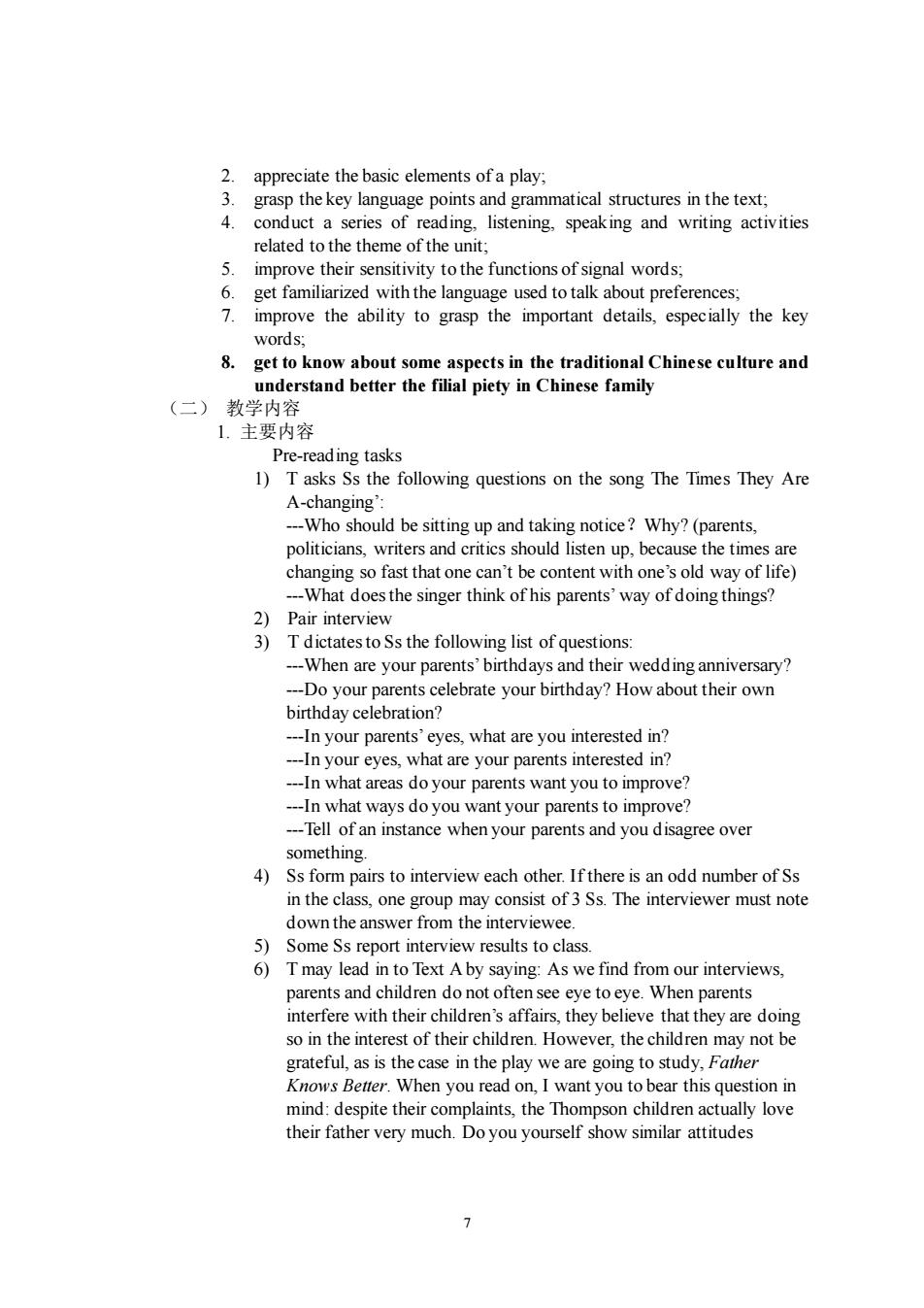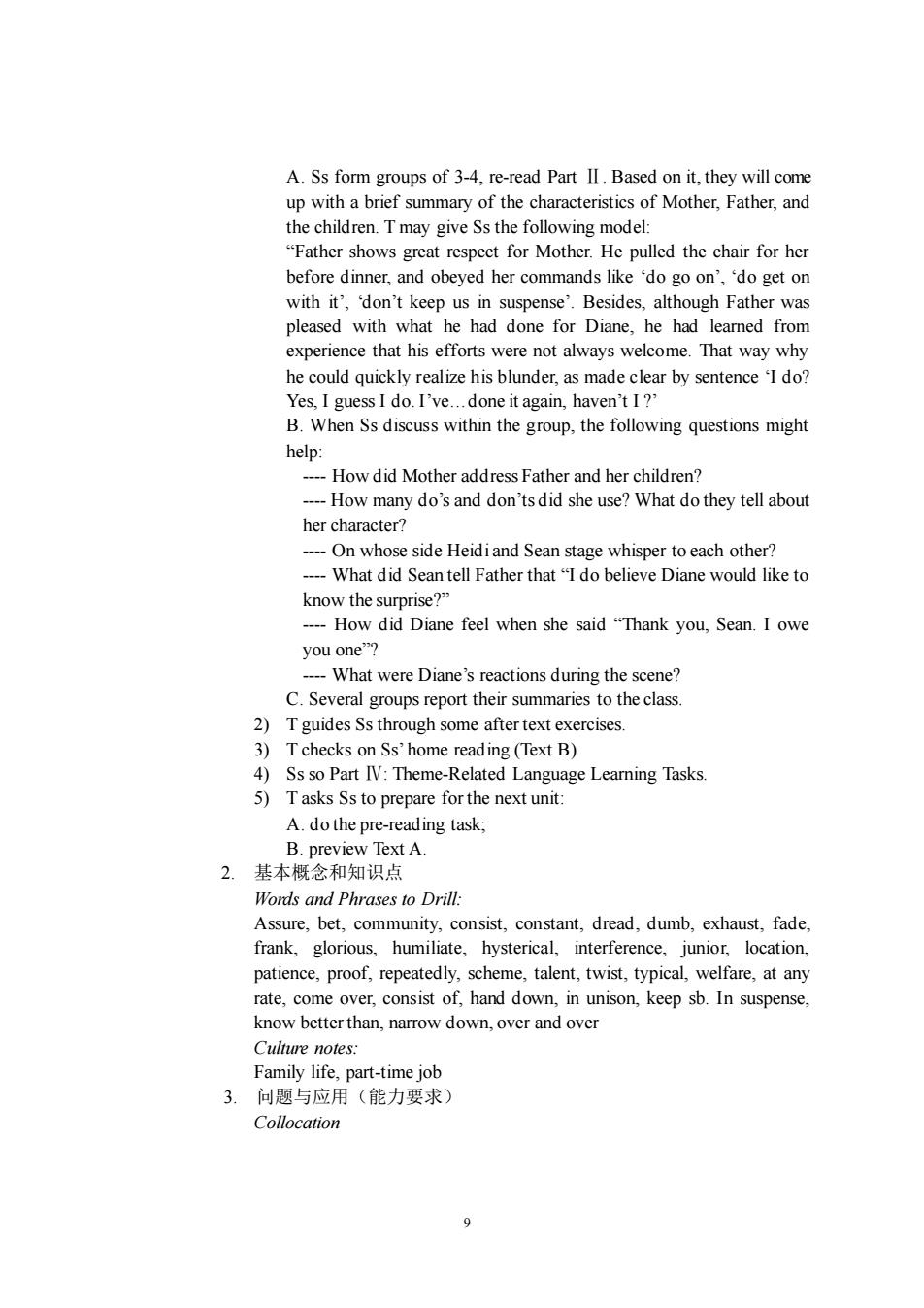
B.And I love the“can do”attitude that follows. C.I think most people feel the same way---except when there are social consequences to not having particular items. 0 Starting ane Different function sand ways to introduce a theme A.S artinga topicdirectl B.Using an anecdote or an incident C.Posing a question D.Ouoting E.An imagined argument between people You can m you r writing by checking your own work.You will also find it helpful to have a classmate evaluate your work.So do the following after writing a.Go through your essay carefully and then answer the questions on the checklist below b Exchange essays and checklists with a partner and check each 3. 问题与应用《能刀要求) 1)Reading:how to identify the theme and topic sentences by skimming and scanning: 2)Writing:how to introduce a theme 3)Speaking:discuss how to spend a life in a happy and meaningful way. (三)思考与实践 1.As an university student.how are you going to prepare for your future career by making full use of the resource on and off campus? 2 the beginning of the essay lead naturally to what you are going to say 2)Is the piece of news thought-provoking? 3)Is the ending relevant to the topic of the essay? 4)Are there any mistakes in spelling? e any mistakes in grammar? Multiple media teaching,communicative,interactive and PBL approach in classroom,role play,teamwork,discussion and video record the job interview. Unit 3 The Generation Gap 目的和要求 ected to the main idea (Father meddled in children's affairs with good intentions,but only to find his efforts unwelcome)and structure three settings,three scenes)of the text. 6
6 B. And I love the “can do” attitude that follows. C. I think most people feel the same way---except when there are social consequences to not having particular items. 6) Starting an essay: Different functions and ways to introduce a theme. A. Starting a topic directly B. Using an anecdote or an incident C. Posing a question D. Quoting E. An imagined argument between people You can improve your writing by checking your own work. You will also find it helpful to have a classmate evaluate your work. So do the following after writing: a. Go through your essay carefully and then answer the questions on the checklist below. b. Exchange essays and checklists with a partner and check each other’s work. 3. 问题与应用(能力要求) 1) Reading:how to identify the theme and topic sentences by skimming and scanning; 2) Writing:how to introduce a theme 3) Speaking:discuss how to spend a life in a happy and meaningful way. (三) 思考与实践 1. As an university student, how are you going to prepare for your future career by making full use of the resource on and off campus? 2. Practice: a mock job interview. 1) Does the beginning of the essay lead naturally to what you are going to say? 2) Is the piece of news thought-provoking? 3) Is the ending relevant to the topic of the essay? 4) Are there any mistakes in spelling? 5) Are there any mistakes in grammar? (四) 教学方法与手段 Multiple media teaching, communicative, interactive and PBL approach in classroom, role play, teamwork, discussion and video record the job interview. Unit 3 The Generation Gap (一) 目的和要求 Students are expected to: 1. understand the main idea (Father meddled in children’s affairs with good intentions, but only to find his efforts unwelcome) and structure ( three settings, three scenes) of the text;

2.appreciate the basic elements of a play, 3.grasp the key language points and grammatical structures in the text; 4.conduct a series of reading,listening.speaking and writing activities related to the theme of the unit: 5 improve their sensitivity to the functions of signal words 6 get wth the nu used to talk about preferences the ability to grasp the important details,especially the key words 8.get to know about some aspects in the traditional Chinese culture and understand better the filial piety in Chinese family (二)教学内容 1.主要内容 Pre-read ing tasks 1)T asks Ss the following questions on the song The Times They Are A-changing'. ---Who should be sitting up and taking notice?Why?(parents criticss ould listen he time one content with one old way or e t does the singer think of his parents'way of doing things? 2)Pair interview 3)T dictates to Ss the following list of questions ---When are your parents'birthdays and their wedding anniversary? --Do your parents celebrate your birthday?How about their own birthday celebration? -In your pa ents'eve s,what are you inte rested in? r eyes what a re yo f paren ested in? In wha t areas do your r parents war t you to improve n wh ways do you ant your parents to improve ---Tell of an instance when your parents and you disagree over something. 4)Ss form pairs to interview each other.If there is an odd number of Ss in the class,one group may consist of 3 Ss.The interviewer must note down the answer from the interviewee ) Some ss report interview results to class Tmay lead in toText Aby 61 ing:As we find from our interviews. nts and childr e eye to e w parents interfe e with their s,they be ve th they are doin so in the interes t of their c ren.However,the childr may not be grateful,as is the case in the play we are going to study,Father Knows Better.When you read on,I want you to bear this question in mind:despite their complaints,the Thompson children actually love their father very much.Do you yourself show similar attitudes 7
7 2. appreciate the basic elements of a play; 3. grasp the key language points and grammatical structures in the text; 4. conduct a series of reading, listening, speaking and writing activities related to the theme of the unit; 5. improve their sensitivity to the functions of signal words; 6. get familiarized with the language used to talk about preferences; 7. improve the ability to grasp the important details, especially the key words; 8. get to know about some aspects in the traditional Chinese culture and understand better the filial piety in Chinese family (二) 教学内容 1. 主要内容 Pre-reading tasks 1) T asks Ss the following questions on the song The Times They Are A-changing’: ---Who should be sitting up and taking notice?Why? (parents, politicians, writers and critics should listen up, because the times are changing so fast that one can’t be content with one’s old way of life) ---What does the singer think of his parents’ way of doing things? 2) Pair interview 3) T dictates to Ss the following list of questions: ---When are your parents’ birthdays and their wedding anniversary? ---Do your parents celebrate your birthday? How about their own birthday celebration? ---In your parents’ eyes, what are you interested in? ---In your eyes, what are your parents interested in? ---In what areas do your parents want you to improve? ---In what ways do you want your parents to improve? ---Tell of an instance when your parents and you disagree over something. 4) Ss form pairs to interview each other. If there is an odd number of Ss in the class, one group may consist of 3 Ss. The interviewer must note down the answer from the interviewee. 5) Some Ss report interview results to class. 6) T may lead in to Text A by saying: As we find from our interviews, parents and children do not often see eye to eye. When parents interfere with their children’s affairs, they believe that they are doing so in the interest of their children. However, the children may not be grateful, as is the case in the play we are going to study, Father Knows Better. When you read on, I want you to bear this question in mind: despite their complaints, the Thompson children actually love their father very much. Do you yourself show similar attitudes

towards your own parents? While-reading tasks 1)A brief introduction to play a.Twrites down on the blackboard the major components of a play: characters,settings,stage directions,language,conflicts,climax, and theme Ss identify the characters in this play c Ss read the directions for Text Organization Exercises 1 and 2 e parts.Tmay drop a hint stage a T explains the functions of stage directions:to set up stage properties in the proper place;to indicate a change in setting:to direct actors'movements,gesture,facial expression,tone of voice etc e.Tinvites one S to read aloud Heidi's speech to the audience at the very beginning of the play,then ask anotherS tore-create Heidi's words into a complete and grammatical paragraph.They may refer to Wrting Strategy to see the stylistic differences between speech and writing f Tdefines conflicts as the essence of a play,a clash of actions ideas,desires or wills.It may happen in three forms:man agains man,man against environment,man against himself.When a conflict develops to the most intensified point it becomes a climax.T asks Ss to find out the form(s) conflict int his play as they later go through the text g.Texplains that,unlike a novelist or short-story writer.a playwright cannot come forward.interrupt the action.and tell the audience what he/she means by a certair ene or explain to them what is going on in the minds of the characters.The audience must conclude by themselves what theme of the play is.T tells Ss that they will do so at the end of reading this play. 2)Texplains language points in Part Iand gives Ss pra ctice Ss sum up the main conflict in Part 4)T explains language points in Part II and gives Ss practice 5)Ss sum up the main conflict in Part II. 6)Texplains language points in Part III and gives Ss practice 7)Ss sum up the m ain conflict in Part III 8)Ss sum up the theme of the play. Post-reading tasks 1)The way they are 8
8 towards your own parents? While-reading tasks 1) A brief introduction to play a. T writes down on the blackboard the major components of a play: characters, settings, stage directions, language, conflicts, climax, and theme. b. Ss identify the characters in this play. c. Ss read the directions for Text Organization Exercises 1 and 2, then scan the play to divide it into three parts. T may drop a hint: just read the stage directions put in brackets. d. T explains the functions of stage directions: to set up stage properties in the proper place; to indicate a change in setting; to direct actors’ movements, gesture, facial expression, tone of voice, etc. e. T invites one S to read aloud Heidi’s speech to the audience at the very beginning of the play, then ask another S to re-create Heidi’s words into a complete and grammatical paragraph. They may refer to Writing Strategy to see the stylistic differences between speech and writing. f. T defines conflicts as the essence of a play, a clash of actions, ideas, desires or wills. It may happen in three forms: man against man, man against environment, man against himself. When a conflict develops to the most intensified point, it becomes a climax. T asks Ss to find out the form(s) of conflict in this play as they later go through the text. g. T explains that, unlike a novelist or short-story writer, a playwright cannot come forward, interrupt the action, and tell the audience what he/she means by a certain scene or explain to them what is going on in the minds of the characters. The audience must conclude by themselves what theme of the play is. T tells Ss that they will do so at the end of reading this play. 2) T explains language points in Part I and gives Ss practice. 3) Ss sum up the main conflict in Part I. 4) T explains language points in Part II and gives Ss practice. 5) Ss sum up the main conflict in Part II. 6) T explains language points in Part III and gives Ss practice. 7) Ss sum up the main conflict in Part III. 8) Ss sum up the theme of the play. Post-reading tasks 1) The way they are

A.Ss form groups of 3-4,re-read Part II.Based on it,they will come up with a brief summary of the characteristics of Mother.Father.and children.Tmay give Ss the follow Father sorectfor Mod the shair for her before dinner,and obeyed her commands like 'do go on','do get on with it'don't keep us in suspense'Besides although father was pleased with what he had done for Diane,he had leamed fr experience that his efforts were not always welcome.That way why he could quickly realize his blunder,as made clear by sentence 'I do? Yes,I guess I do.I've...done it again,haven't I?' B.When Ss discuss within the group,the following questions might help ----How did Mother address Father and her children? --How many do's and don'ts did she use?What do they tell about her character? On whose side Heidiand Sean stage whisper to each other? ---What did Sean tell Father that"I do believe Diane would like to know the surprise?" --How did Diane feel when she said "Thank you,Sean.I owe you one"? -What were Diane's reactions during the scene? C.Several groups report their summaries to the class. 2)T guides Ss through some after text exercises. 3 Tchecks on Ss' home re ading(Text B) 4)Ss so Part IV:Theme-Related Language Learning Tasks. 5)Tasks Ss to prepare for the next unit: A.do the pre-reading task; Text A. 2. 基本概念和知识点 Words and Phrases to Drill: Assure,bet,community,consist,constant,dread,dumb,exhaust,fade. frank. glorious, humiliate hysterical,interference junior, location patience,proof,repeatedly,scheme,talent,twist,typical,welfare,at any rate,come over,consist of,hand down,in unison,keep sb.In suspense, know better than.narrow down.over and over notes: Family lfe,part-time job 3.问题与应用(能力要求) Collocation
9 A. Ss form groups of 3-4, re-read Part Ⅱ. Based on it, they will come up with a brief summary of the characteristics of Mother, Father, and the children. T may give Ss the following model: “Father shows great respect for Mother. He pulled the chair for her before dinner, and obeyed her commands like ‘do go on’, ‘do get on with it’, ‘don’t keep us in suspense’. Besides, although Father was pleased with what he had done for Diane, he had learned from experience that his efforts were not always welcome. That way why he could quickly realize his blunder, as made clear by sentence ‘I do? Yes, I guess I do. I’ve…done it again, haven’t I ?’ B. When Ss discuss within the group, the following questions might help: ---- How did Mother address Father and her children? ---- How many do’s and don’ts did she use? What do they tell about her character? ---- On whose side Heidi and Sean stage whisper to each other? ---- What did Sean tell Father that “I do believe Diane would like to know the surprise?” ---- How did Diane feel when she said “Thank you, Sean. I owe you one”? ---- What were Diane’s reactions during the scene? C. Several groups report their summaries to the class. 2) T guides Ss through some after text exercises. 3) T checks on Ss’ home reading (Text B) 4) Ss so Part Ⅳ: Theme-Related Language Learning Tasks. 5) T asks Ss to prepare for the next unit: A. do the pre-reading task; B. preview Text A. 2. 基本概念和知识点 Words and Phrases to Drill: Assure, bet, community, consist, constant, dread, dumb, exhaust, fade, frank, glorious, humiliate, hysterical, interference, junior, location, patience, proof, repeatedly, scheme, talent, twist, typical, welfare, at any rate, come over, consist of, hand down, in unison, keep sb. In suspense, know better than, narrow down, over and over Culture notes: Family life, part-time job 3. 问题与应用(能力要求) Collocation